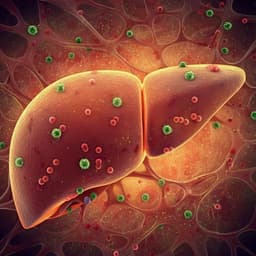
Medicine and Health
Whole-genome sequencing reveals novel ethnicity-specific rare variants associated with Alzheimer’s disease
D. Shigemizu, Y. Asanomi, et al.
This groundbreaking study by Daichi Shigemizu, Yugo Asanomi, Shintaro Akiyama, Risa Mitsumori, Shumpei Niida, and Kouichi Ozaki reveals rare genetic variants associated with Alzheimer's disease and uncovers critical insights into its pathogenesis. Two key variants were identified, along with several candidate genes, paving the way for future research in AD.
~3 min • Beginner • English
Introduction
Alzheimer’s disease (AD) is a highly prevalent multifactorial neurodegenerative disorder with no curative treatments, and current therapies only delay progression. AD is classified as early-onset (EOAD, <65 years), often caused by rare autosomal dominant mutations in APP, PSEN1, or PSEN2, and late-onset (LOAD, ≥65 years), the majority of cases, with complex genetic and environmental determinants. LOAD heritability is estimated at 60–80%, with APOE ε4 being the strongest known genetic risk factor but explaining only part of the heritability. Large GWAS have identified multiple common-variant risk loci, yet much of the heritability remains unexplained because GWAS primarily capture common variants with small effect sizes. Rare variants (MAF < 0.01) with potentially larger effects remain underexplored in LOAD. Advances in next-generation sequencing, particularly WGS, provide broader coverage than WES and can detect rare coding variants missed by capture-based approaches. In this study, the authors applied WGS to clinically characterized Japanese individuals with probable AD and cognitively normal elderly controls, followed by validation in an independent Japanese case–control cohort, to comprehensively investigate rare pathogenic variants associated with AD. They report two candidate rare variants—one in an olfactory receptor gene (OR5G1) and a stop-gain variant in MLKL—and explore functional consequences and gene-based signals to shed light on AD mechanisms.
Literature Review
The paper situates its work within prior genetic studies of AD. It notes that APOE ε4 is the strongest common genetic risk factor for LOAD but accounts for only a portion of heritability. Large-scale GWAS have identified 29 or more risk loci across cohorts exceeding hundreds of thousands of individuals, explaining additional but still incomplete heritability. However, GWAS focus on common variants with small effects, leaving rare variants undercharacterized. Next-generation sequencing has enabled discovery of rare causal mutations in Mendelian disorders and de novo mutations in cancers; WGS, in particular, offers broader coverage than WES and can detect more coding variants due to capture limitations in WES. The study also references prior associations in olfactory receptor genes in Japanese AD GWAS and literature implicating necroptosis via MLKL in neurodegenerative processes, thereby motivating a rare-variant WGS approach in a Japanese cohort to uncover ethnicity-specific variants contributing to AD risk.
Methodology
Study cohorts and design: Blood samples and data were obtained from the NCGG Biobank. Discovery was conducted using WGS in Japanese subjects comprising 140 AD cases and 798 cognitively normal (CN) elderly controls (≥60 years). After QC, 139 AD and 794 CN remained. Replication used an independent Japanese case–control cohort (approximately 1604 AD and 1235 CN) for validation of top signals. All AD diagnoses followed National Institute on Aging–Alzheimer’s Association criteria; CN had subjective complaints but normal cognition on comprehensive testing (e.g., MMSE ≥ 23). Ethics approvals and expert clinical evaluations were in place.
WGS generation and processing: High-quality genomic DNA was prepared using the TruSeq DNA PCR-Free kit and sequenced on Illumina HiSeqX/NovaSeq 6000 platforms with 151 bp paired-end reads. Reads were aligned to GRCh37 with BWA-MEM (v0.7.15). PCR duplicates were marked/removed with Picard (v2.21). Variant calling used GATK HaplotypeCaller with joint genotyping (GenotypeGVCFs). Variant Quality Score Recalibration followed GATK Best Practices. Stringent filtering thresholds were applied to SNPs and indels (e.g., depth, genotype quality, QD, QUAL, SOR, FS, MQ, MQRankSum, ReadPosRankSum, ExcessHet). PLINK-based QC included genotype probability thresholds, relatedness (PI_HAT > 0.25), missingness <5%, MAF filters, call rate >0.95, and HWE tests; population structure was examined via PCA with 1000 Genomes references.
Variant annotation and frequency: Variants were annotated with ANNOVAR for functional consequences (e.g., missense, nonsense, splicing). Minor allele frequencies were obtained from East Asian reference databases (1000 Genomes, gnomAD, regional databases). Variants were categorized as rare (MAF < 0.01), infrequent (0.01–0.05), or common (>0.05).
Association analyses: Variant-level rare-variant association testing in coding regions was conducted using Fisher’s exact test in the discovery WGS dataset. Top signals were forwarded to replication genotyping (multiplex PCR-based assays or Sanger sequencing) in the independent cohort with Fisher’s exact tests and meta-analysis across discovery and replication. Logistic regression with covariate adjustment (age, sex) was used for select variants.
Gene-based burden tests: Gene-wide burden tests on rare coding variants assessed cumulative effects assuming the same direction of effect; Bonferroni and BH procedures were used for multiple testing correction. Genes with significant burden were further evaluated. Network-level analysis of candidate genes (BH-corrected P threshold) utilized NetworkAnalyst with the STRING interactome (confidence cutoff 0.20), with network topology metrics (degree, betweenness) to identify hub genes. Networks were visualized with Cytoscape.
Functional assays for MLKL variants: Cloning and mutagenesis generated Myc-tagged wild-type and variant MLKL constructs (including a stop-gain and missense variants). HEK293 cells were transfected for immunocytochemistry and cell-death assays. Necroptosis-related cell death was quantified using SYTOX Green nuclear staining. To assess amyloid processing, APP Swedish mutant-expressing HEK293 cells (APPsw-293) were transfected with MLKL constructs; Aβ40 and Aβ42 concentrations in supernatants were quantified by ELISA, and the Aβ42/Aβ40 ratio was computed. Experiments included multiple independent biological repeats with replicate wells; Welch’s t-tests or Student’s t-tests were used, with P < 0.05 considered significant.
qRT-PCR validation of hub genes: For hub genes identified by network analysis, peripheral blood expression was measured by qRT-PCR in 10 AD and 10 CN samples. Expression was normalized to hB2M using relative quantification. Genes assessed included NCOR2, DMD, NEDD4, and PLEC.
Databases and software: gnomAD, KRGDB, ToMMo/8.3KJPN were used for population frequencies. Analyses employed PLINK, R, Ruby, ANNOVAR, NetworkAnalyst, STRING, and Cytoscape.
Key Findings
- Discovery WGS and replication identified two rare variant candidates associated with AD in a Japanese cohort:
• An olfactory receptor missense variant: abstract reports OR5G1 (rs140604166, c.815G>A, p.R272H) as a candidate; replication analyses in the main text highlight an Asian-specific olfactory receptor variant with consistent direction and meta-analysis significance (e.g., Pmeta ≈ 1.36 × 10−3), with logistic regression adjusted OR ≈ 2.20 (95% CI 1.24–3.91).
• A stop-gain variant in MLKL (rs763812068, c.142C>T, p.Q48X) emerging from gene-based tests, suggesting loss-of-function in a necroptosis effector.
- Variant-level analysis of coding variants also detected the known APOE ε4 risk variant at genome-wide significance (OR ≈ 4.23, 95% CI 2.90–6.15) in this dataset.
- Gene-based burden testing on rare coding variants identified MLKL as significant after Bonferroni correction (Pbon ≈ 0.010). Multiple rare MLKL variants contributed to the signal.
- Functional characterization of MLKL variants:
• Cells expressing the MLKL stop-gain variant showed a significantly reduced proportion of cell death compared with wild-type and a missense variant, consistent with impaired necroptosis (e.g., t-test P values around 0.0003 and 0.0078 in independent experiments).
• Expression of MLKL variants in APPsw-293 cells altered the Aβ42/Aβ40 balance measured by ELISA, indicating a potential effect on amyloid processing.
- Network analysis of candidate genes (from gene-based burden testing) yielded a PPI network with 245 nodes and 254 edges, highlighting eight topological hubs. Four were confirmed as brain-expressed and prioritized as functionally important hub genes potentially linked to AD mechanisms: NCOR2, PLEC, DMD, and NEDD4.
- qRT-PCR in peripheral blood (10 AD vs 10 CN) showed that NCOR2 and DMD were lowly expressed; PLEC and NEDD4 were detectable but showed no significant differential expression (PLEC P = 0.39; NEDD4 P = 0.77), indicating limited utility as blood biomarkers.
- Population specificity: The olfactory receptor variant appeared enriched or specific in East Asian databases (e.g., gnomAD East Asian MAF ≈ 0.016; observed in KRGDB and ToMMo/Japanese datasets), supporting an ethnicity-specific rare AD-associated variant.
Discussion
This study addresses the gap in AD genetics whereby rare variants with potentially larger effects are underexplored relative to common variants. Using WGS in a Japanese cohort, the authors identified candidate rare variants associated with AD, including an olfactory receptor missense variant with replication support and a stop-gain MLKL variant implicated by gene-based burden testing. The MLKL findings, coupled with functional assays, suggest that impaired necroptosis can contribute to AD pathogenesis by allowing survival of cells that would normally undergo programmed cell death and by perturbing amyloid processing (altered Aβ42/Aβ40 ratio). These results add to accumulating evidence implicating inflammatory cell-death pathways in neurodegeneration. Network-based integration of candidate genes highlighted hub genes (NCOR2, PLEC, DMD, NEDD4) associated with synaptic and memory-related processes, suggesting convergent mechanisms affecting neuronal function and plasticity. Although peripheral blood expression of these hubs did not differentiate AD from controls, their expression in brain and known roles in memory pathways support relevance to central mechanisms. Collectively, the findings extend the genetic architecture of AD by highlighting rare, potentially ethnicity-specific variants and pointing to necroptosis and synaptic regulation as mechanistic avenues for further investigation.
Conclusion
The study leverages WGS and replication cohorts in a Japanese population to identify rare, ethnicity-specific variants associated with AD risk, notably a missense variant in an olfactory receptor gene and a stop-gain variant in MLKL. Functional assays support a pathogenic role for MLKL loss-of-function in reducing necroptosis and altering amyloid peptide balance, suggesting a mechanistic link to AD. Gene-based burden testing and network analysis further prioritize brain-expressed hub genes (NCOR2, PLEC, DMD, NEDD4) implicated in memory and synaptic function. These results contribute to explaining part of the missing heritability of AD and underscore the importance of rare variants and population-specific analyses. Future work should include larger multi-ethnic WGS cohorts, deeper functional studies in neuronal models and brain tissue, and exploration of necroptosis-targeted interventions and pathways affecting synaptic transmission and plasticity.
Limitations
- Sample size and power: Although relatively large for WGS in an AD cohort, the discovery set remains modest, limiting power to detect very rare variants and to precisely estimate effect sizes. The replication cohort strengthens evidence but inconsistencies in reported counts highlight potential data handling or reporting variances.
- Ethnicity-specificity: Findings may be population-specific (East Asian), potentially limiting generalizability to other ancestries and necessitating validation in diverse cohorts.
- Functional assays: In vitro assays in HEK293/APPsw-293 models may not fully recapitulate neuronal or brain microenvironment contexts. Directionality and magnitude of Aβ42/Aβ40 changes may vary by model and require confirmation in neuronal systems or in vivo.
- Biomarker translation: Peripheral blood qRT-PCR did not show differential expression for prioritized hub genes, limiting immediate biomarker utility.
- Potential technical and annotation inconsistencies: OCR-like errors and gene/variant nomenclature inconsistencies in the text underscore the need for careful curation; nonetheless, the central conclusions (MLKL LOF involvement; olfactory receptor rare variant association; hub genes) are supported by the analyses presented.
Related Publications
Explore these studies to deepen your understanding of the subject.







